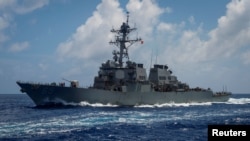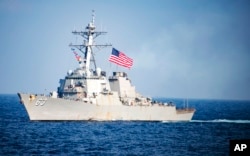Passage of two U.S. Navy ships through the Taiwan Strait in February, the fourth such move since mid-2018, shows Washington’s growing support for Taiwan against threats from China, Asia scholars said this week.
Observers say the passages are aimed at showing China that the U.S. Navy has regularized patrols in the East and South China seas despite — and because of — China’s maritime expansion.
“I think the United States, by demonstrating its determination and resolve to be more actively implementing naval operations, is to send a message to China that they don’t like Chinese more aggressive and more assertive behavior in this region,” said Andrew Yang, secretary-general of the think tank Chinese Council of Advanced Policy Studies in Taiwan.
On Feb. 25-26, the U.S. Navy’s guided-missile destroyer Stethem and a dry cargo ship, the Cesar Chavez, passed through the 160-kilometer-wide strait separating Taiwan from China.
More frequent ship movement
International law allows U.S. naval ships to pass through the Taiwan Strait, but their arrivals without a specific motive are almost always read as a political signal.
During the first of the most recent four actions, the USS Mustin guided missile destroyer and the USS Benfold anti-aircraft ship sailed northbound through the strait. Taiwan’s defense ministry announced the passage with no objection. China bristled.
Taiwan looks to U.S. military support for its defense against China, which has the world’s third most powerful armed forces. Taiwan wants more help from the United States, the island government’s deputy China policymaker Chiu Chui-cheng told VOA last week.
Recent ship movement in the strait confirms the U.S. Navy’s Indo-Pacific Command as an ever-present force in the Western Pacific, said Alexander Huang, strategic studies professor at Tamkang University in Taiwan.
“The United States Navy, or Indo-PACOM, have been doing maritime reconnaissance near the Chinese coastline on a regular basis,” Huang said. “It’s more like regular training exercises.”
Sympathy in Washington
The U.S. government sees democratic, self-ruled Taiwan as one of several East Asian friends that form a maritime perimeter around China, its former Cold War foe and a trade adversary today.
China claims self-ruled Taiwan as part of its own territory. In January Chinese President Xi Jinping reiterated in a speech that his government could use force against the island if needed to make the two sides unify.
U.S. President Donald Trump has sparred with China over the past year on trade tariffs, adding friction to an ever-tense relationship. His administration has approved two arms sales to Taiwan, while Congress passed an act last year calling for more high-level Taipei-Washington visits.
“If you look at how supportive the Congress, the bipartisan support for Taiwan has been, it’s really quite unprecedented,” said Yun Sun, East Asia Program senior associate with the Stimson Center think tank in Washington, D.C. “So I think there’s a domestic calling here in the United States to demonstrate more support for Taiwan at this time.”
Chinese reaction
China has flown military aircraft near Taiwan’s air defense zone at least 15 times since 2015, per one local scholar’s calculations. Local media reported that 38 Chinese planes flew near Taiwan’s south coast in late January. China’s first aircraft carrier also passes through the strait, apparently as a warning to Taiwan.
Leaders in Beijing resent Taiwan President Tsai Ing-wen for rejecting a dialogue condition that each side sees itself as part of a single China. She was elected in 2016 and said last month she plans to seek another four-year term next year.
After the U.S. Congress approved a measure in 2017 to allow visits by Navy vessels and military officials to Taiwan, Chinese embassy Minister Li Kexin said any such ship calls at the major Taiwan port in Kaohsiung would justify the use of force.
China will keep expanding its high-seas naval capability, particularly in the East China Sea near Taiwan and in the widely disputed South China Sea, analysts in Taiwan say. But the country will “carefully calculate” whether future moves might worsen relations with Washington, Yang said.







